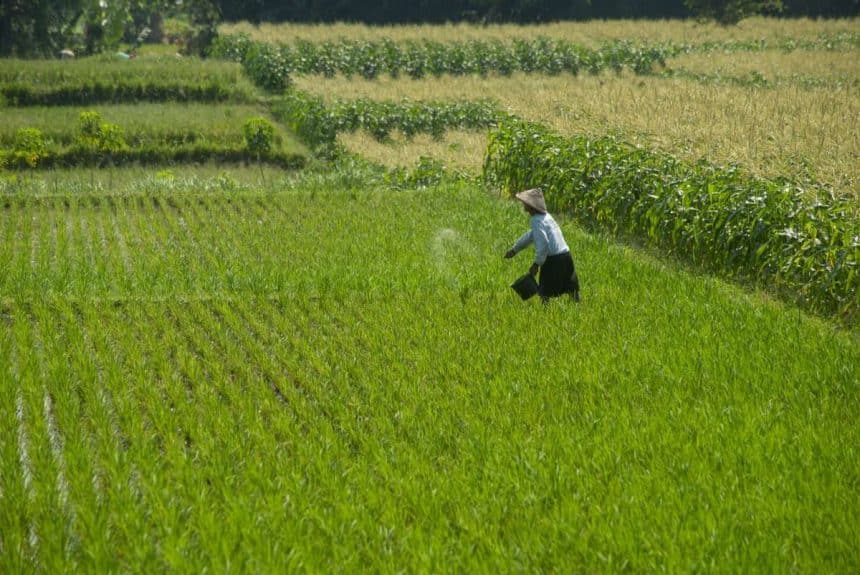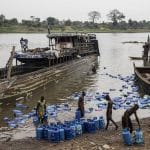Liga Asuransi – Dear readers, welcome to our blog which focuses on risk management and insurance in various sectors, including agriculture. This time, we review a very important and relevant topic, namely risk management and the role of insurance in supporting national food security, especially in the Indonesian agricultural sector. This article is intended to provide practical and strategic insights for farmers, agribusiness actors, government and the private sector. If you find this article useful, feel free to share it with your colleagues. Don’t miss the hundreds of other informative articles on this blog that can broaden your horizons.
Food Security Challenges in Indonesia
Food security is one of the main pillars in maintaining the social, economic and political stability of a country. In Indonesia, with a population of more than 270 million people, the need for sufficient, safe, nutritious and affordable food is a national strategic priority. The government through various programs has set National Food Security as the main agenda, especially amidst global dynamics such as climate change, geopolitical crises and international supply chain disruptions.
However, despite these great efforts, Indonesia’s agricultural sector still faces many challenges that threaten the stability of food security. Dependence on seasonal cropping patterns, minimal commodity diversification, limited access to modern technology, and vulnerability to natural disasters such as floods, droughts and pest attacks are the main factors that cause large losses for farmers and have a direct impact on national food availability.
In addition, market price fluctuations and the lack of guaranteed income for farmers result in low incentives to increase productivity. In situations like this, risk management becomes very important to ensure the sustainability of the agricultural sector while supporting the achievement of long-term food security.
This article will thoroughly discuss how risk management can be applied in the agricultural sector, the types of risks that need to be anticipated, the role of technology and innovation, and the importance of collaboration between government, the private sector and financial institutions – including the vital role of agricultural insurance – in strengthening the foundations of Indonesia’s food security.
Key Risks in Agricultural Supply Chains
The agricultural supply chain in Indonesia consists of various stages ranging from production, post-harvest, distribution, to consumption. Each of these stages has potential risks that can disrupt the smooth running of the food security system. Identifying and understanding these risks is the first step in building an effective risk management strategy.
- Climate and Extreme Weather Risks
Indonesia is a tropical country with increasingly unpredictable weather patterns due to global climate change. Changes in growing seasons, excessive rainfall, extreme drought, flooding, and even haze from forest fires are examples of risks that directly affect crop yields. This uncertainty causes crop failure and large economic losses for farmers.
- Pest and Plant Disease Attacks
Pest infestations such as planthoppers, mice, armyworms, and diseases such as leaf blight or stem rot can cause extensive damage to food crops. Farmers’ lack of access to control technology and low knowledge about biosecurity exacerbates this condition. This risk has a direct impact on the volume and quality of agricultural products.
- Commodity Price Fluctuations
Prices of agricultural products are very volatile and vulnerable to changes in global market conditions and government policies. When selling prices are low, farmers do not make a decent profit even though production is high. This instability makes it difficult to plan farming businesses and triggers a decrease in motivation to plant.
- Infrastructure and Logistics Limitations
The distribution of agricultural products to markets is often hampered by poor infrastructure conditions, such as damaged roads, limited cold storage, and a lack of transportation vehicles. This causes products to spoil quickly or not reach the market on time, especially for perishable commodities such as vegetables and fruit.
- Social and Political Risks
Land conflicts, sudden changes in regulations, and unequal access to land and capital are risks that affect the agricultural sector systemically. Food security programs will not be effective if they are not accompanied by fair and sustainable policies.
Addressing these risks cannot be done in isolation. An integrated approach is needed that includes data-based risk management, use of technology, financial support, and insurance protection to maintain the continuity of food production and distribution.
Risk Management Strategy for Farmers and Government
In dealing with the complexity of risks in the agricultural sector, a risk management strategy that is comprehensive, structured, and can be implemented by all stakeholders, from small farmers to policy makers at the national level, is needed. This strategy must be proactive, not reactive, with an emphasis on prevention, protection and post-loss recovery.
- Periodic Risk Mapping and Identification
A very crucial first step is to carry out regular risk mapping based on region, type of commodity, planting season, and specific potential threats such as natural disasters or pest outbreaks. The government, through the Ministry of Agriculture and the National Food Agency, needs to provide data that is easily accessible, accurate and real time for farmers and farming business actors. The weather-based early warning system must also be extended to the village level.
- Diversification of Commodities and Cropping Patterns
One form of risk mitigation is through commodity diversification and implementing planting patterns that are adaptive to climate and market conditions. Farmers need to be given technical guidance and incentives not to just grow one type of crop (monoculture), but to develop an integrated agricultural system that is more resistant to external shocks.
- Strengthening Farmer Groups and Cooperatives
Individual farmers generally have low bargaining power. Therefore, strengthening farmer institutions in the form of farmer groups and cooperatives is important to support collective purchasing of production facilities, joint risk management, as well as access to markets and financing. The government needs to encourage the formation of digital-based agricultural cooperatives so that they are able to compete and survive in difficult conditions.
- Risk Management Training and Education
Risk management is not just a theory, but a practice that must be understood and carried out directly by farmers. Therefore, regular training on risk management, financial literacy and the use of technology needs to be a priority program. The involvement of agricultural extension workers, academics and insurance companies in this training is very crucial.
- Expansion of Insurance and Financing Schemes
An equally important strategy is providing access to financial protection through affordable agricultural insurance and risk-based financing schemes. The government can expand premium subsidies and collaborate with financial institutions to provide People’s Business Credit (KUR) specifically for the food sector which is equipped with insurance protection.
Through the strategies above, risk management in the agricultural sector can become a strong foundation for achieving strong, productive and sustainable food security.
The Role of Technology in Risk Mitigation
Digital transformation in the agricultural sector opens up great opportunities to strengthen food security through more sophisticated, fast and accurate risk mitigation. Technology not only increases production efficiency, but also provides real solutions in identifying, managing and reducing the risks faced by farmers and food supply chain actors.
- Internet of Things (IoT) for Crop and Weather Monitoring
IoT sensors enable real-time monitoring of soil moisture, air temperature and weather conditions. This information can be used to determine appropriate planting, watering, and fertilizing times. This technology also helps farmers anticipate potential pest attacks or plant diseases before major damage occurs.
- Use of Drones and Satellite Imagery
Drones and satellites are now increasingly being used in precision agriculture. Both can provide a broad and accurate picture of land conditions, plant health levels, and potential risks from flooding or drought. This data is very useful in risk evaluation, planning cropping patterns, and even in parametric-based insurance claims processes.
- Mobile Application for Education and Farming Business Management
Many smartphone-based applications provide market information, the latest commodity prices, and daily and weekly weather predictions. Apart from that, this application can help farmers record agricultural activities, calculate production costs, and plan the distribution of harvest results. Access to this information helps farmers make smarter, less risky decisions.
- Big Data and Artificial Intelligence (AI) in Risk Prediction
By collecting data from various sources, such as satellite imagery, weather reports and historical production data, artificial intelligence can be used to predict potential future risks. AI also helps in developing appropriate mitigation strategies, such as the best planting patterns or optimal distribution times.
- Technology in Agricultural Insurance Services
Insurance companies are starting to use technology to speed up the claims verification process and determine the extent of damage automatically through satellite data and field sensors. This speeds up the disbursement of claims and increases farmers’ confidence in insurance services.
The application of technology in mitigating agricultural risks is no longer an option, but a necessity. For this technology to truly have an impact, there needs to be synergy between the government, technology providers, financial institutions and farmers. With the support of appropriate regulations, technology will become the main driving force in creating a national food system that is resilient and adaptive to changing times.
Involvement of Financial and Insurance Institutions
A resilient agricultural sector depends not only on production strength and technology, but also on a supportive system of financing and financial protection. In the context of risk management to support the National Food Security program, the role of financial institutions and the insurance industry is very crucial in creating a safety net that allows farmers to survive amidst uncertainty.
- Risk Financing by Financial Institutions
Access to capital is one of the biggest challenges for farmers, especially small farmers. Banking institutions, cooperatives and agricultural fintech need to provide risk-based lending products, where farmers’ creditworthiness is not only seen from collateral, but also from their business risk profile. People’s Business Credit (KUR) in the agricultural sector should be synergized with risk analysis and insurance protection so that it is sustainable.
Apart from financing working capital, financial institutions can also support the purchase of technology-based agricultural equipment, the development of modern irrigation, and the construction of food storage infrastructure. For this reason, incentives and ease of regulation are needed so that financial institutions are more active in entering the agricultural sector.
- Agricultural Insurance as a Risk Transfer Tool
Agricultural insurance is one of the most effective forms of risk management, especially in dealing with the risk of crop failure, extreme weather and natural disasters. The Rice Farming Business Insurance Program (AUTP) and Cattle Farming Business Insurance (AUTS) rolled out by the government are positive steps. However, penetration is still low due to limited socialization, access to information and the complexity of claims procedures.
In this case, insurance brokers can take a strategic role as a liaison between farmers, farmer groups and insurance companies. Insurance companies can also develop new products such as parametric insurance or weather indexes, which offer automated claims processes based on weather data or satellite results.
- Multisector Collaboration
Synergy between financial institutions, the insurance industry, government and the private sector is needed to form a comprehensive agricultural risk protection ecosystem. The Public-Private Partnership (PPP) scheme can be a model of sustainable financing and protection.
With the support of an inclusive financial system and strong insurance protection, farmers will have greater confidence to produce optimally and contribute to national food security.
Case Study: Climate Change and Its Impact on Food Production
Climate change is the most real and urgent global challenge in the context of food security. In Indonesia, the impact is not only visible in increasing average temperatures, but also in drastically changing rainfall patterns, increasing frequency of natural disasters, and disruption to agricultural ecosystems.
Case: Harvest Failure Due to Changes in the Planting Season in Central Java
In 2023, thousands of hectares of rice farming land in the Demak and Grobogan areas, Central Java, will experience crop failure due to delays in the rainy season. Rainfall which usually starts falling in October is delayed until December, causing farmers to suffer huge losses because the plants lack water in the early growth period. The impact is not only felt by farmers, but also on the supply of rice to local markets which causes prices to rise.
Furthermore, when the rain finally fell, the intensity was very high and caused flooding in low-lying areas. Farmers experience double losses because their planted fields are submerged in water, exacerbating the risk of crop failure. This incident shows how weather uncertainty caused by climate change can drastically derail food production plans.
Systemic Impact
The impacts of climate change are not only local, but also systemic. Disrupted production in one region can create pressure on national supply, increase dependence on imports, and reduce national food reserves. This emphasizes the importance of building climate-adaptive risk management and protection systems.
The Role of Adaptation and Insurance
Adaptation to climate change through the use of drought-resistant varieties, improving irrigation systems, and preparing planting calendars based on weather data are medium-term solutions. On the other hand, agricultural insurance can provide short-term financial protection so that farmers do not suffer when a crop failure occurs.
The Important Role of Insurance Brokers such as L&G Insurance Brokers
In the agricultural risk management ecosystem, insurance brokers play a very important role as strategic liaisons between farmers, farmer groups, insurance companies and financial institutions. L&G Insurance Broker, as one of the leading brokers in Indonesia, has extensive experience in designing risk protection solutions that suit the characteristics of the national agricultural sector.
L&G not only helps choose the best insurance products, but also provides education to farmers and agricultural business actors regarding the importance of protection against the risk of crop failure, extreme weather and natural disasters. Apart from that, L&G also assists the claims process so that it runs faster, more transparently and more fairly. With a consultative approach and technology support based on digital systems such as LIGASYS, L&G is able to provide efficient and integrated services, which ultimately strengthens the sustainability of the National Food Security Program through comprehensive and professional risk protection.
Conclusions and Recommendations for Government and Stakeholders
National food security cannot be achieved only by increasing agricultural production. Real challenges such as climate change, natural disasters, price fluctuations, and uneven infrastructure require a more holistic approach through structured and adaptive risk management.
Risk management is not just a mitigation strategy, but must be the foundation of all agricultural policies and practices, from planting season planning to crop distribution. The government has a major role in providing risk data, supporting access to financing, expanding insurance protection, and creating regulations that are friendly to innovation.
Private parties, including financial institutions and insurance companies, must be given space and incentives to play an active role in creating a strong risk protection ecosystem. Technology must be utilized optimally to transform traditional approaches into systems that are more precise, data-driven and responsive.
With strong collaboration between farmers, government, the financial sector and technology providers, Indonesia can build a food security system that is not only productive, but also resilient to shocks. This is the time for risk management to become a top priority in welcoming a safe, sustainable and independent food future.
Looking for insurance products? Don’t waste your time and contact us now
HOTLINE L&G 24 JAM: 0811-8507-773 (CALL – WHATSAPP – SMS)
Website: lngrisk.co.id
Email: oktoyar.meli@lngrisk.co.id
—















